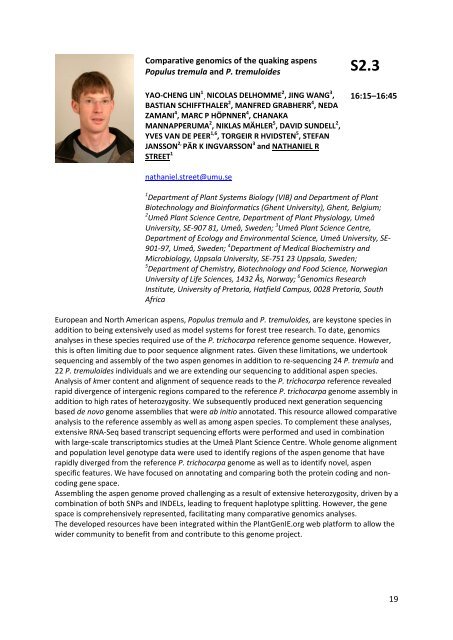Create successful ePaper yourself
Turn your PDF publications into a flip-book with our unique Google optimized e-Paper software.
Comparative genomics of the quaking aspens<br />
Populus tremula and P. tremuloides<br />
S2.3<br />
YAO-CHENG LIN 1 , NICOLAS DELHOMME 2 , JING WANG 3 , 16:15–16:45<br />
BASTIAN SCHIFFTHALER 2 , MANFRED GRABHERR 4 , NEDA<br />
ZAMANI 4 , MARC P HÖPNNER 4 , CHANAKA<br />
MANNAPPERUMA 2 , NIKLAS MÄHLER 5 , DAVID SUNDELL 2 ,<br />
YVES VAN DE PEER 1,6 , TORGEIR R HVIDSTEN 5 , STEFAN<br />
JANSSON 2, PÄR K INGVARSSON 3 and NATHANIEL R<br />
STREET 1<br />
nathaniel.street@umu.se<br />
1 Department of Plant Systems Biology (VIB) and Department of Plant<br />
Biotechnology and Bioinformatics (Ghent University), Ghent, Belgium;<br />
2 Umeå Plant Science Centre, Department of Plant Physiology, Umeå<br />
University, SE-907 81, Umeå, Sweden; 3 Umeå Plant Science Centre,<br />
Department of Ecology and Environmental Science, Umeå University, SE-<br />
901-97, Umeå, Sweden; 4 Department of Medical Biochemistry and<br />
Microbiology, Uppsala University, SE-751 23 Uppsala, Sweden;<br />
5 Department of Chemistry, Biotechnology and Food Science, Norwegian<br />
University of Life Sciences, 1432 Ås, Norway; 6 Genomics Research<br />
Institute, University of Pretoria, Hatfield Campus, 0028 Pretoria, South<br />
Africa<br />
European and North American aspens, Populus tremula and P. tremuloides, are keystone species in<br />
addition to being extensively used as model systems for forest tree research. To date, genomics<br />
analyses in these species required use of the P. trichocarpa reference genome sequence. However,<br />
this is often limiting due to poor sequence alignment rates. Given these limitations, we undertook<br />
sequencing and assembly of the two aspen genomes in addition to re-sequencing 24 P. tremula and<br />
22 P. tremuloides individuals and we are extending our sequencing to additional aspen species.<br />
Analysis of kmer content and alignment of sequence reads to the P. trichocarpa reference revealed<br />
rapid divergence of intergenic regions compared to the reference P. trichocarpa genome assembly in<br />
addition to high rates of heterozygosity. We subsequently produced next generation sequencing<br />
based de novo genome assemblies that were ab initio annotated. This resource allowed comparative<br />
analysis to the reference assembly as well as among aspen species. To complement these analyses,<br />
extensive RNA-Seq based transcript sequencing efforts were performed and used in combination<br />
with large-scale transcriptomics studies at the Umeå Plant Science Centre. Whole genome alignment<br />
and population level genotype data were used to identify regions of the aspen genome that have<br />
rapidly diverged from the reference P. trichocarpa genome as well as to identify novel, aspen<br />
specific features. We have focused on annotating and comparing both the protein coding and noncoding<br />
gene space.<br />
Assembling the aspen genome proved challenging as a result of extensive heterozygosity, driven by a<br />
combination of both SNPs and INDELs, leading to frequent haplotype splitting. However, the gene<br />
space is comprehensively represented, facilitating many comparative genomics analyses.<br />
The developed resources have been integrated within the PlantGenIE.org web platform to allow the<br />
wider community to benefit from and contribute to this genome project.<br />
19



